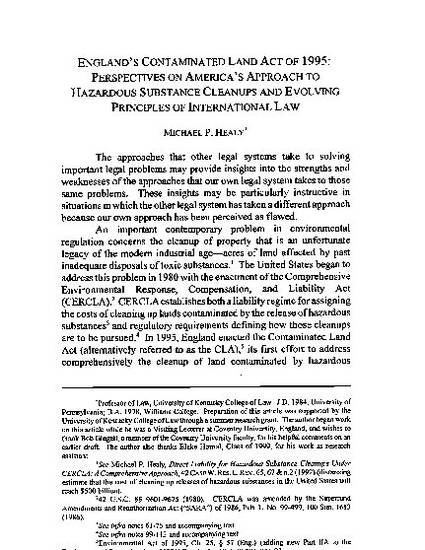
An important contemporary problem in environmental regulation concerns the cleanup of property that is an unfortunate legacy of the modem industrial age—acres of land affected by past inadequate disposals of toxic substances. The United States began to address this problem in 1980 with the enactment of the Comprehensive Environmental Response, Compensation, and Liability Act (CERCLA). CERCLA establishes both a liability regime for assigning the costs of cleaning up lands contaminated by the release of hazardous substances and regulatory requirements defining how those cleanups are to be pursued. In 1995, England enacted the Contaminated Land Act (alternatively referred to as the CLA), its first effort to address comprehensively the cleanup of land contaminated by hazardous substances. England's new approach to the cleanup of contaminated land was determined in part by its government's view that CERCLA defined regulatory provisions that are too controversial and costly.
Close consideration of the CLA should accordingly provide rich insights into an alternative approach to remediating contaminated land. In addition to providing an important perspective for reconsidering America's approach to the remediation of contaminated land, England's CLA also should be considered along with CERCLA in a less parochial legal context, that is in the context of international environmental law. Observers of the rapid development of international environmental law have made claims that several important principles have evolved that are broadly accepted by all nations. National legislation may therefore be examined to assess the extent to which it adheres to these purportedly generally accepted principles. The Contaminated Land Act, as well as our own national law of contaminated land cleanup, can be most profitably assessed by reference to two broadly accepted evolving principles—the precautionary principle and the polluter-pays principle. Insights can also be gained by considering the extent to which the two statutory schemes reflect in the treatment of their own citizens two evolving international law principles that govern international relations—the principles of adequate consultation and nondiscrimination.
This Article will compare and contrast the CERCLA regime for remediating contaminated land with the CLA's principal provisions and requirements. This discussion will be organized by reference to the four emerging principles of international environmental law.

Journal of Natural Resources & Environmental Law, Vol. 13, No. 2 (1998), pp. 289-315.